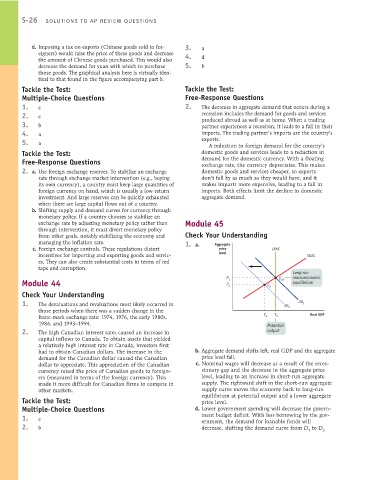Page 872 - Krugmans Economics for AP Text Book_Neat
P. 872
S-26 SOLUTIONS TO AP REVIEW QUESTIONS
d. Imposing a tax on exports (Chinese goods sold to for- 3. a
eigners) would raise the price of these goods and decrease 4.
the amount of Chinese goods purchased. This would also d
decrease the demand for yuan with which to purchase 5. b
those goods. The graphical analysis here is virtually iden-
tical to that found in the figure accompanying part b.
Tackle the Test: Tackle the Test:
Multiple-Choice Questions Free-Response Questions
1. e 2. The decrease in aggregate demand that occurs during a
2. e recession includes the demand for goods and services
3. b produced abroad as well as at home. When a trading
partner experiences a recession, it leads to a fall in their
4. a imports. The trading partner’s imports are the country’s
5. a exports.
A reduction in foreign demand for the country’s
Tackle the Test: domestic goods and services leads to a reduction in
Free-Response Questions demand for the domestic currency. With a floating
exchange rate, the currency depreciates. This makes
2. a. Use foreign exchange reserves. To stabilize an exchange domestic goods and services cheaper, so exports
rate through exchange market intervention (e.g., buying don’t fall by as much as they would have, and it
its own currency), a country must keep large quantities of makes imports more expensive, leading to a fall in
foreign currency on hand, which is usually a low-return imports. Both effects limit the decline in domestic
investment. And large reserves can be quickly exhausted aggregate demand.
when there are large capital flows out of a country.
b. Shifting supply and demand curves for currency through
monetary policy. If a country chooses to stabilize an
exchange rate by adjusting monetary policy rather than Module 45
through intervention, it must divert monetary policy
from other goals, notably stabilizing the economy and Check Your Understanding
managing the inflation rate. 1. a. Aggregate
c. Foreign exchange controls. These regulations distort price LRAS
level
incentives for importing and exporting goods and servic- SRAS
es. They can also create substantial costs in terms of red
tape and corruption.
Long-run
P 1 E LR macroeconomic
Module 44 P 2 E 2 equilibrium
Check Your Understanding
1. The devaluations and revaluations most likely occurred in AD 2 AD 1
those periods when there was a sudden change in the
Y 2 Y 1 Real GDP
franc-mark exchange rate: 1974, 1976, the early 1980s,
1986, and 1993–1994. Potential
2. The high Canadian interest rates caused an increase in output
capital inflows to Canada. To obtain assets that yielded
a relatively high interest rate in Canada, investors first
had to obtain Canadian dollars. The increase in the b. Aggregate demand shifts left, real GDP and the aggregate
demand for the Canadian dollar caused the Canadian price level fall.
dollar to appreciate. This appreciation of the Canadian c. Nominal wages will decrease as a result of the reces-
currency raised the price of Canadian goods to foreign- sionary gap and the decrease in the aggregate price
ers (measured in terms of the foreign currency). This level, leading to an increase in short-run aggregate
made it more difficult for Canadian firms to compete in supply. The rightward shift in the short-run aggregate
other markets. supply curve moves the economy back to long-run
equilibrium at potential output and a lower aggregate
Tackle the Test: price level.
Multiple-Choice Questions d. Lower government spending will decrease the govern-
1. c ment budget deficit. With less borrowing by the gov-
ernment, the demand for loanable funds will
2. b decrease, shifting the demand curve from D to D
1 2

